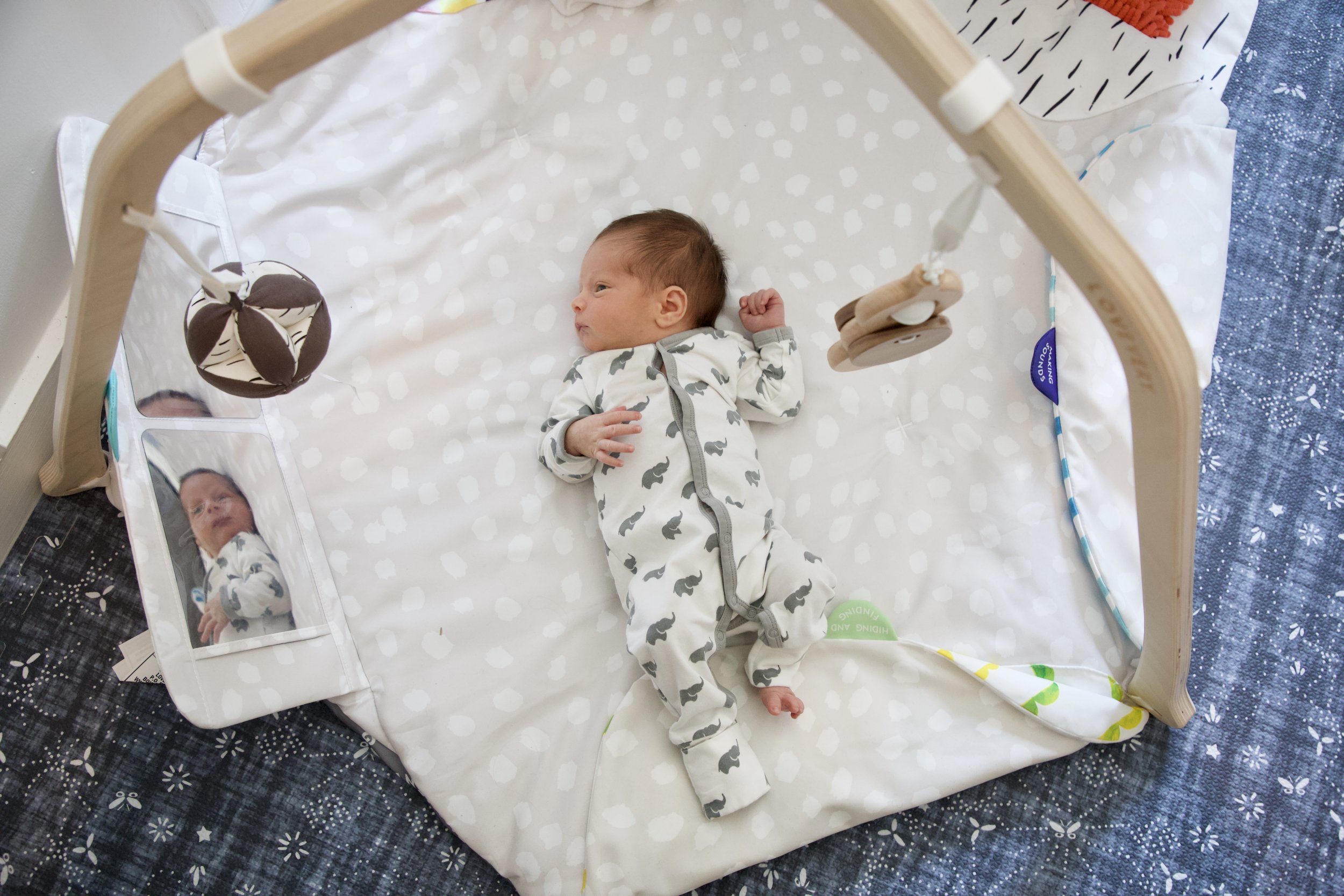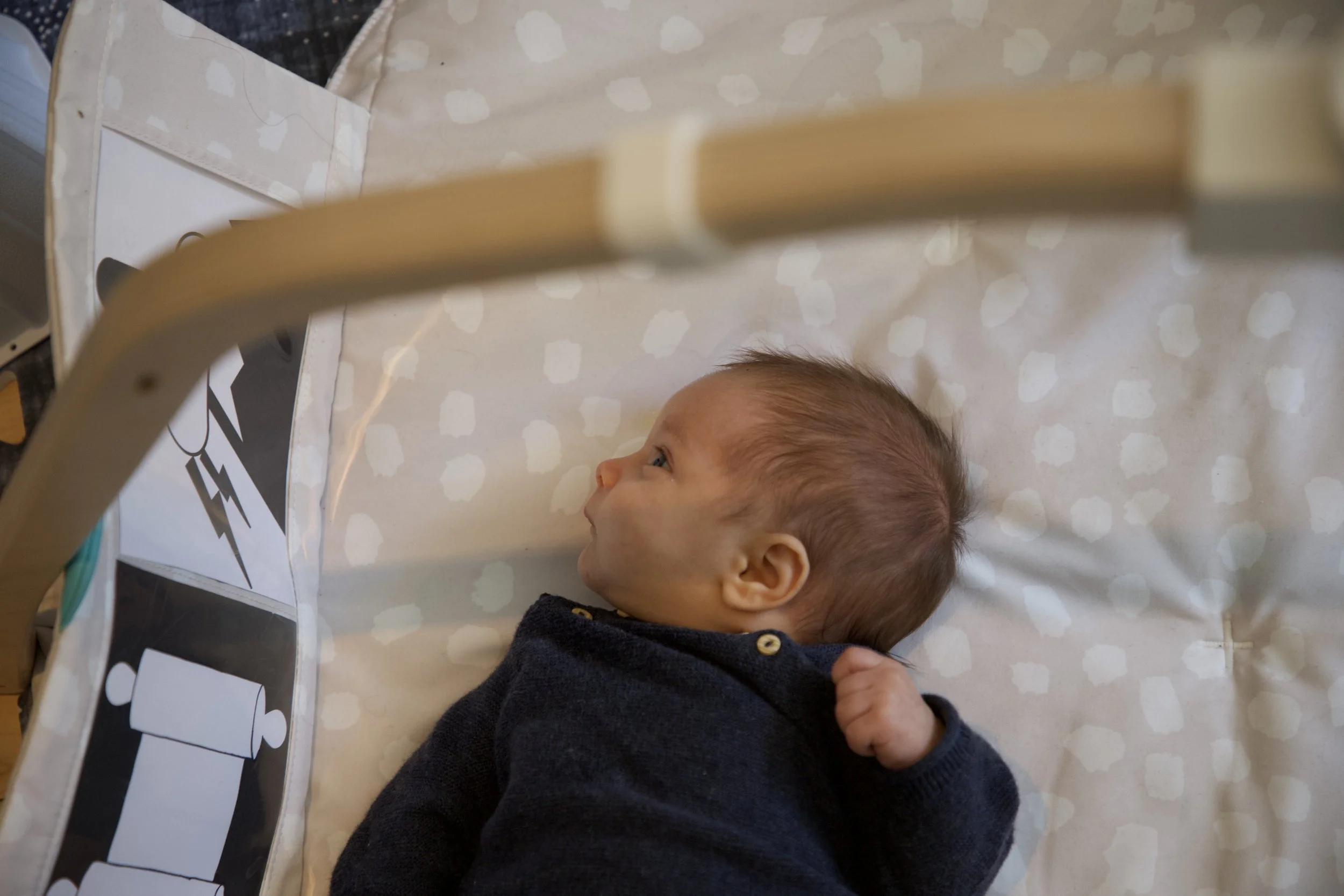Montessori Newborn Activities
This post may contain affiliate links, which means I may earn a small commission if you buy through my link but does not change your price.
With my newly minted one-year-old I have found myself reflecting a lot on the last year and where we started with Montessori a year ago. I love talking about Montessori for newborns because it is so simple but also something people really don’t think of when they think of Montessori. I thought I would share some ways to practice Montessori with your newborn.
The Symbiotic Period
The first 6-8 weeks are referred to as the symbiotic period, a period of time when the baby is adjusting to the world and the family is adjusting to life with the baby. During this period (and beyond!) the focus is really on connecting, slowing down, and spending time together. Skin-to-skin is a crucial activity, especially in the symbiotic period. While Montessori with newborns might often be imagined as a baby lying under a mobile that truly isn’t the focus, especially in the beginning.
An important way of practicing Montessori with newborns is learning their cues. “Follow the child” is an essential part of Montessori. Babies give cues that they are tired, hungry, and want to be held. Learning those cues is an important Montessori with newborns activity. It respects the baby as the individual he or she is. Some babies eat more often, some babies sleep less.
This slow connected time getting to know your baby is the most important Montessori for newborns activity.
Montessori Newborn Mobiles
We got a set of the four basic Montessori mobiles.
The Munari Mobile
There is a series of four classic mobiles you can introduce to your baby. The first is the Munari mobile. Newborns do not have color discrimination yet and love high contrast (black and white) images. This is why the first of the Montessori mobiles is black and white.
We also loved our Lovevery mobile which is a different take on the Munari mobile. Honestly, Yitzchak loved it a lot more than the classic Montessori mobile. It flips for when the baby is older to a pretty colored side. We used it over our changing table and it made diaper changes so much better. We brought it across the country on our road trip and Yitzchak was always thrilled to see it come out.
The Octahedron Mobile
The Octahedron mobile is the second in the Montessori newborn mobile series. It has three octahedron shapes in primary colors. The shapes are lightweight. Like all the Montessori mobiles the idea is that it moves with the natural air movement of the room rather than with mechanics or with us moving it. This is generally introduced sometime between 6-10 weeks.
The Gobbi Mobile
The third mobile in the Montessori newborn mobile set is the Gobbi mobile. It features five balls in different shades of the same color. Ours was blue, but they come in many colors. The balls are also hung at a gradient with the darkest ball hanging lowest and the lightest hanging highest. The balls together form a line in a 45 degree angle. Since the balls are heavier this one moves a little less than the other Montessori newborn mobiles.
The Gobbi mobile is often introduced around 8-10 weeks but it can vary. Many will wait longer if their baby is still interested in the Octahedron mobile. We introduced the Gobbi mobile quite late, at around 15 weeks because we were on a road trip and didn’t bring it. (We brought our Lovevery mobile and the Octahedron mobile, both of which kept his attention). Still, even at 15 weeks Yitzchak was interested in the Gobbi mobile.
The Montessori Dancer Mobile
The last of the classic series of 4 mobiles for newborns is the Montessori dancer mobile. It is made with lightweight, reflective material to look like dancers dancing in the natural airflow of the room. This one is generally introduced after the Gobbi mobile and when exactly varies.
Tactical Mobiles
After the Montessori dancer mobile generally people introduce tactile mobiles that babies can grab at such as ribbons or bells. Yitzchak loved the bell on his Lovevery play gym. A Montessori puzzle ball (which we also had on our Lovevery play gym) is another great example of a tactile mobile. These are generally introduced in the later newborn stage as the newborn becomes more interested in grabbing at things.
The Mirror
A mirror is an important part of a Montessori nursery. It doesn’t have to be anything fancy but a mirror down on the ground that allows the baby to watch themselves and see the room reflected is such a wonderful item for a baby. Yitzchak loved the mirror from the very beginning and still at a year loves the mirror.
Mirrors offer an experiment in cause and effect. They encourage gross motor movement as the newborn tries to look at themselves in tummy time (older infants will use a pull-up bar above a mirror to pull up). Babies will concentrate on their face in the mirror. It is probably our most used “toy” of the whole first year and the closest to an essential for Montessori newborns.
Black and White Cards
Yitzchak loved black and white cards. They are the perfect Montessori newborn activity and they can be free. You can find some online and print them out on your home computer. We also got them in our Lovevery subscription box. Black and white cards can be put on the wall for your baby to look up to from tummy time or you can use them for visual tracking, moving them slowly in front of your baby.
Start with simpler black and white cards and as your baby loses interest in them, introduce more complex ones.
Freedom of Movement
Another simple yet essential Montessori newborn activity is freedom of movement. Freedom of movement can mean different things to different people but some recommendations include skipping mittens and socks, skipping the swaddle, and laying your baby down on the floor instead of in “containers” such as bouncers and swings. Personally, I found giving Yitzchak time just in his diaper allowed more freedom of movement for him.
Respect
Another way to practice Montessori with newborns is to practice respecting your newborn. Every activity is a Montessori newborn activity whether it is feeding them, changing their diaper, or giving them floor time with a mobile. Try to think of diaper changes as a Montessori newborn activity and narrate what you are doing before you do it.
Tell your baby “I am going to open your diaper now” and wait a few seconds before opening it. Move slowly, using gentle hands, and telling them what you are doing before you do it.
Another aspect of respect is respecting their concentration. If your baby is focusing on something be it a mobile, black and white cards, or a plant outside, pause and wait for them to look away before moving on. If your newborn is concentrating on a mobile wait for them to lose interest or look away before taking them for a diaper change.
I think it is essential to remember that while there are Montessori materials for newborns (such as the mobiles) the most important thing at this time is to get to know your infant and give them respect. Every activity is a Montessori newborn activity. Nursing is just as much a Montessori activity for newborns as the Munari mobile is. The key principles of observation and following the child are essential to doing Montessori with newborns.





